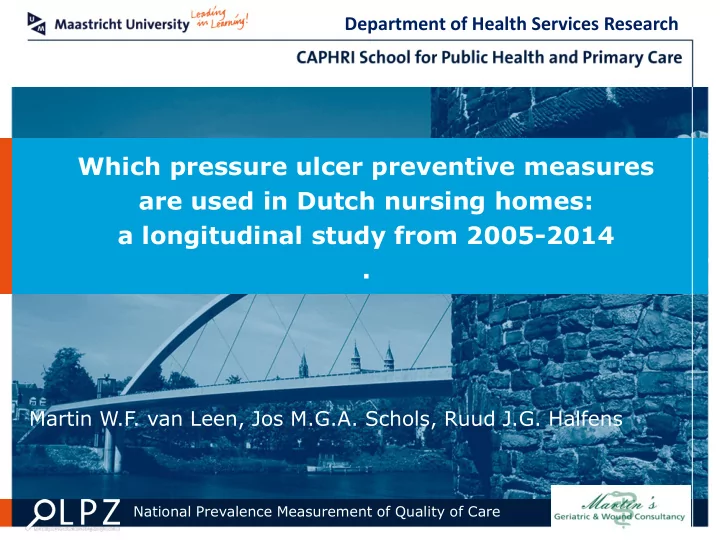

Department of Health Services Research Which pressure ulcer preventive measures are used in Dutch nursing homes: a longitudinal study from 2005-2014 . Martin W.F. van Leen, Jos M.G.A. Schols, Ruud J.G. Halfens National Prevalence Measurement of Quality of Care
CONFLICT OF INTEREST DISCLOSURE I have no potential conflict of interest to report
Department of Health Services Research Background • Pressure Ulcers are an important and distressing care problem in nursing homes - painful - negative impact on quality of life - expensive (materials, nursing care time) • The use of evidence based preventive measures is very important National Prevalence Measurement of Quality of Care
Department of Health Services Research Causal and risk factors of PUs • Causal factors: – Pressure – Pressure in combination with shear • Possible contributing risk factors: – Mobility problems – Skin condition (dry or wet, temperature changes, anatomical changes) – Nutritional status – Age National Prevalence Measurement of Quality of Care
Department of Health Services Research Prevention of PUs • Integral approach – Risk assessment – Skin assessment/care – Assessment/optimisation of nutritional status – Pressure relief and shear prevention – Repositioning National Prevalence Measurement of Quality of Care
Department of Health Services Research Aim of study • Which PU preventive measures are used in Dutch nursing homes? • Can we do better? National Prevalence Measurement of Quality of Care
Department of Health Services Research Method • Secondary analysis of LPZ-data of Dutch nursing homes 2005-2014 • Three risk groups: – Patients at low risk (Braden score of 17-19) – Patients at medium/high risk (Braden score <17) – Patients with a PU cat 2, 3 or 4 National Prevalence Measurement of Quality of Care
Department of Health Services Research Method • Use of preventive measures assessed via LPZ: – Skin protection (use of emollients) – Management dehydration/malnutrition – Floating heels/heel devices – Pressure redistributing mattresses – Repositioning National Prevalence Measurement of Quality of Care
Department of Health Services Research Results: Characteristics residents 2015 Year of measurement 2005 2006 2007 2008 2009 2010 2011 2012 2013 2014 Number of patients 6400 7392 11096 6756 7345 6165 3710 2442 1493 1553 1620 Number of 90 108 148 92 175 163 89 64 39 38 46 institutions Mean age 82.4 82.6 82.2 81.9 83.6 83.4 83.8 83.9 82.8 81.8 82.7 Mean % females 73.3 74.9 73.4 73.3 76.8 76.8 74.1 72.6 69.8 70.5 69,8 Mean Braden Score 15.2 15.0 15.0 14.9 15.4 15.6 15.4 15.4 15.5 15.7 15,6 Mean Care * * 33.3 31.6 34.3 33.1 31.8 32.2 33.0 35.0 35,9 Dependency National Prevalence Measurement of Quality of Care
Department of Health Services Research Prevalence of Pressure Ulcers (cat 2,3 and 4) in Dutch Nursing Homes 18 16 14 12 10 8 6 4 2 0 2006 2007 2008 2009 2010 2011 2012 2013 2014 2015 National Prevalence Measurement of Quality of Care
Department of Health Services Research Skin protection 70 60 50 40 Low risk Medium/high risk 30 PU 20 10 0 2005 2006 2007 2008 2009 2010 2011 2012 2013 2014 2015 National Prevalence Measurement of Quality of Care
Department of Health Services Research Management of Dehydration/Malnutrition 70 60 50 40 Low risk Medium/high risk 30 PU 20 10 0 2006 2007 2008 2009 2010 2011 2012 2013 2014 2015 National Prevalence Measurement of Quality of Care
Department of Health Services Research Floating heels/heel devices 70 60 50 40 Low risk Medium/high risk 30 PU 20 10 0 2006 2007 2008 2009 2010 2011 2012 2013 2014 2015 National Prevalence Measurement of Quality of Care
Department of Health Services Research Pressure redistributing mattresses 100 90 80 70 60 Low risk 50 Medium/high risk PU 40 30 20 10 0 2006 2007 2008 2009 2010 2011 2012 2013 2014 2015 National Prevalence Measurement of Quality of Care
Department of Health Services Research Repositioning 60 50 40 Low risk 30 Medium/high risk PU 20 10 0 2006 2007 2008 2009 2010 2011 2012 2013 2014 2015 National Prevalence Measurement of Quality of Care
Conclusions • Improved use over • Stable use over the the years: years: Skin protection (61%) Repositioning (37%) Management Pressure redistributing dehydration/ mattresses (89%) malnutrition (63%) Care heels (56%) National Prevalence Measurement of Quality of Care
Department of Health Services Research General conclusion: Although the prevalence of PUs in Dutch nursing homes has declined considerably in the last years, PU prevention still can be done better. National Prevalence Measurement of Quality of Care
Department of Health Services Research Possible reasons • Care complexity of nursing home residents is expected to rise because of the aging in place policy in The Netherlands. • Problems to get enough qualified nursing staff. • PU prevalence is no longer a care quality indicator anymore, which leads to decrease of awareness and already to a (slight) rise of the prevalence again. National Prevalence Measurement of Quality of Care
Department of Health Services Research What do we need to perform better? • Better implementation of (less complex) guidelines • Coaching on the job • Better support of nursing staff by management • Evidence about which combination of PU prventive measures is the best and how to tailor PU prevention to the individual patient National Prevalence Measurement of Quality of Care
Department of Health Services Research National Prevalence Measurement of Quality of Care
Department of Health Services Research Thank you for your attention Thank you for your attention National Prevalence Measurement of Quality of Care
Recommend
More recommend